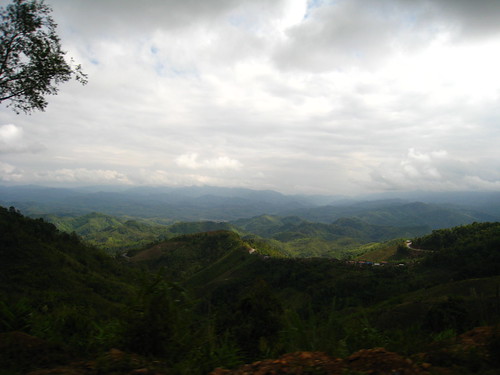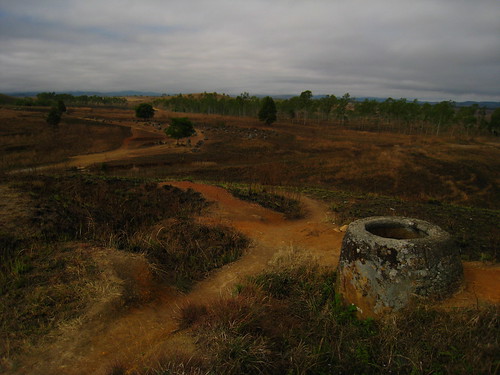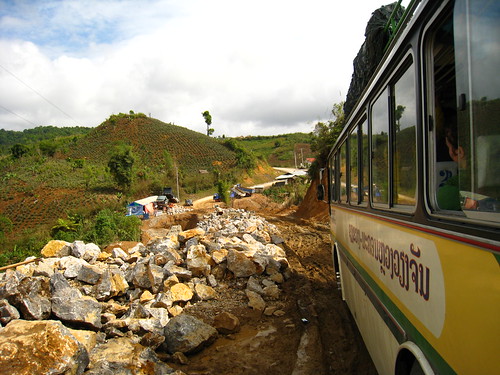 Phonsavan is famous for two reasons. The first is that it is the site of the Plain of Jars. Jars carved from solid rock 2,000 to 1,500 years ago. The second is that it is one of the heavily bombed parts of Laos during the 'Vietnam War'. Quite something considering Laos is the most heavily bombed country in the world. A legacy that the locals have put to use by using the war scrap they can get their hands on. Both of these reasons make Phonsavan worth a visit. What makes a visit to Phonsavan special is that it feels like you really are off the beaten track.
Phonsavan is famous for two reasons. The first is that it is the site of the Plain of Jars. Jars carved from solid rock 2,000 to 1,500 years ago. The second is that it is one of the heavily bombed parts of Laos during the 'Vietnam War'. Quite something considering Laos is the most heavily bombed country in the world. A legacy that the locals have put to use by using the war scrap they can get their hands on. Both of these reasons make Phonsavan worth a visit. What makes a visit to Phonsavan special is that it feels like you really are off the beaten track.  The Vietnam War is pretty firmly rooted in popular culture. Most people in the West know that the Americans fought a war there. What is less well known is that the Americans also fought in Laos, in what was known as the 'Secret War'. It was a 'Secret War' because the Americans had agreed not to fight a war there with the Soviets and Vietnamese in Geneva Agreements. Laos was significant because it was originally seen as the key to safeguarding South East Asia from Communism. The French fought Dien Bien Phu to defend Laos from Vietnam, the battle that they lost and led to their withdrawal from Indochina. When Eisenhower handed the Presidency over to JFK he told him in a briefing that Laos held the key to South East Asia and if it fell to Communism the whole of South East Asia would crumble. The so-called domino effect. The Vietnamese did not withdraw their troops following the Geneva Agreements and while the US did withdraw troops, they soon replaced them with advisers. US policy was to fight a holding war to stop the North Vietnamese (under the cover of the Pathet Laos forces) to take control of the country. Once the North Vietnamese had been defeated in South Vietnam Laos would be saved. Laos also took on greater significance for the Americans because the majority of the Ho Chi Minh trail passed through it. The Americans used the Hmong (originally recruited by the French) to fight a guerilla war against the Pathet Laos and NVA forces. To support them they used airpower. An excellen insight into American involvement is provided by Christpher Robbins in 'The Raven's' the story of US pilots (Forward Air Controllers) based in Laos and Thailand who targeted the US bombing raids. While the war may have been considered 'Secret' that didn't stop Laos becoming the most heavily bombed country in the world. Whatever your opinion of US involvement in Laos the bombing has cast a long legacy over the country, particularly in Xieng Khuan Province in northern Laos and in the southern provinces where the Ho Chi Minh Trail passed. It makes you wonder whether it is correct to refer to this period as the 'Vietnam War'or rather the 'Second Indochina War'. Mines Advisory Group (MAG) is an NGO that is clearing the area of UXOs. They have an office on the main street in Phonsavan which has information about what they are currently doing to clear the bombs and how the bombs got there in the first place.
The Vietnam War is pretty firmly rooted in popular culture. Most people in the West know that the Americans fought a war there. What is less well known is that the Americans also fought in Laos, in what was known as the 'Secret War'. It was a 'Secret War' because the Americans had agreed not to fight a war there with the Soviets and Vietnamese in Geneva Agreements. Laos was significant because it was originally seen as the key to safeguarding South East Asia from Communism. The French fought Dien Bien Phu to defend Laos from Vietnam, the battle that they lost and led to their withdrawal from Indochina. When Eisenhower handed the Presidency over to JFK he told him in a briefing that Laos held the key to South East Asia and if it fell to Communism the whole of South East Asia would crumble. The so-called domino effect. The Vietnamese did not withdraw their troops following the Geneva Agreements and while the US did withdraw troops, they soon replaced them with advisers. US policy was to fight a holding war to stop the North Vietnamese (under the cover of the Pathet Laos forces) to take control of the country. Once the North Vietnamese had been defeated in South Vietnam Laos would be saved. Laos also took on greater significance for the Americans because the majority of the Ho Chi Minh trail passed through it. The Americans used the Hmong (originally recruited by the French) to fight a guerilla war against the Pathet Laos and NVA forces. To support them they used airpower. An excellen insight into American involvement is provided by Christpher Robbins in 'The Raven's' the story of US pilots (Forward Air Controllers) based in Laos and Thailand who targeted the US bombing raids. While the war may have been considered 'Secret' that didn't stop Laos becoming the most heavily bombed country in the world. Whatever your opinion of US involvement in Laos the bombing has cast a long legacy over the country, particularly in Xieng Khuan Province in northern Laos and in the southern provinces where the Ho Chi Minh Trail passed. It makes you wonder whether it is correct to refer to this period as the 'Vietnam War'or rather the 'Second Indochina War'. Mines Advisory Group (MAG) is an NGO that is clearing the area of UXOs. They have an office on the main street in Phonsavan which has information about what they are currently doing to clear the bombs and how the bombs got there in the first place.  The Plain of Jars is an interesting place though not necessarily spectacular. There are jars, carved from rocks, scattered all over the area. A couple of the jars having carvings on them. There are 3 main sights that tourists can visit, the other sites (160 different sites and in total 4,000 jars) are still being cleared of UXOs (unexplored ordinance) from the 'Vietnam War'. The biggest of the jars weighs 6 tonnes. There are many theories surrounding their existence (including that they were used to store rice whiskey) the most likely is that they were funeral urns and the size and location denoted the importance of the corpse. The first site has the 6 tonne jar and the most number of jars (around 250) scattered over a couple of hills. The second site has ninety jars. The third is the prettiest site, involving a short walk across rice fields and up a hill. On the way to the third site is the wreck of a Russian tank (or at least what has been left behind by scrap metal dealers). The landscape is pot marked by bomb sites. When you visit each site there are signs up by MAG which state the number of UXO found when the site was cleared. A constant reminder of the legacy of the war are markers on the ground telling you where it is safe to walk.
The Plain of Jars is an interesting place though not necessarily spectacular. There are jars, carved from rocks, scattered all over the area. A couple of the jars having carvings on them. There are 3 main sights that tourists can visit, the other sites (160 different sites and in total 4,000 jars) are still being cleared of UXOs (unexplored ordinance) from the 'Vietnam War'. The biggest of the jars weighs 6 tonnes. There are many theories surrounding their existence (including that they were used to store rice whiskey) the most likely is that they were funeral urns and the size and location denoted the importance of the corpse. The first site has the 6 tonne jar and the most number of jars (around 250) scattered over a couple of hills. The second site has ninety jars. The third is the prettiest site, involving a short walk across rice fields and up a hill. On the way to the third site is the wreck of a Russian tank (or at least what has been left behind by scrap metal dealers). The landscape is pot marked by bomb sites. When you visit each site there are signs up by MAG which state the number of UXO found when the site was cleared. A constant reminder of the legacy of the war are markers on the ground telling you where it is safe to walk. What makes Phonsavan interesting is that it isn't a touristy place. While I was there it was very cold (due to the elevation) and cloudy often with spurts of drizzle. The town after being flattened in the war has been rebuilt and reflects the conformity of new design in South-East Asia. After we finished our tour of the Plain of Jars we went in search of the war memorials. For many nations war is a defining feature of their nationhood, their war memorials are given pride of place. In Phonsavan, a place so clearly defined by war, has its war memorials on a couple of hills 3kms south of town. There is not any obvious way to reach them and no sign that people regularly visit them. We wandered south and then through a maze of streets before deciding that we would have to climb the hill to reach the Vietnamese War Memorial (which was out of sight by this stage). Generally walking up a hill is not a major concern, however, the thought of UXOs concentrates the mind. We made it to the top of the hill without incident and stumbled upon the Vietnamese War Memorial, which was locked. Out of nowhere a very old man appeared who we concluded was the caretaker. He spoke French and charged us 3,000 Kip to go inside. I can only assume that it is his only source of income as he seemed to live in a hut in the corner of the memorial. The memorial is impresive, two soldiers stand side by side pushing forward against their common imperialist foe. The Lao memorial is a complete contrast, it is simply a stupa, again it was locked, and the only sign of life were the kids playing football outside. Our journey back from the Lao memorial involved climbing through a couple of barbed wire fences. On my walk back into town I came across a couple of locals one of whom had a jacket with USA emblazoned across the back. The Second Indochina War has undoubtedly shaped how the people of Phonsavan live their lives but outside of the danger of UXOs they all seem to want to forget it ever took place. A testament to Laos never really wanting the war in the first place.
 The journey to and from Phonsavan by bus is quite an experience. Like every journey in northern Laos it takes a long time. It is rare to come across traffic as you climb up and down the side of mountains and pass through villages. Large parts of the journey were through thick clouds and then you would suddenly appear out the other side with a spectacular view. At times the view is the same as peering out of a plane window with mountain peaks poking through the clouds. For some reason on bus journeys in Laos when they make a toilet stop (it seems to be only one stop irrespective of the length of the journey) they stop in the middle of nowhere, never in a village. At one point we pulled over to change a tyre. We stopped on the outskirts of a hilltribe village and a group of kids formed up, curious at the sight of the bus stopping and westerners getting off. We also had a would-be stunt man on board. One of the conductors climbed out of a side window and onto the roof. The bus was moving pretty quickly down hill out of the lunch stop. It looked like he was just going to look out the window, before pulling himself up on to the roof. All of the westerners were amazed, whilst the locals didn't bat an eyelid. We think he climbed out so he could smoke.
The journey to and from Phonsavan by bus is quite an experience. Like every journey in northern Laos it takes a long time. It is rare to come across traffic as you climb up and down the side of mountains and pass through villages. Large parts of the journey were through thick clouds and then you would suddenly appear out the other side with a spectacular view. At times the view is the same as peering out of a plane window with mountain peaks poking through the clouds. For some reason on bus journeys in Laos when they make a toilet stop (it seems to be only one stop irrespective of the length of the journey) they stop in the middle of nowhere, never in a village. At one point we pulled over to change a tyre. We stopped on the outskirts of a hilltribe village and a group of kids formed up, curious at the sight of the bus stopping and westerners getting off. We also had a would-be stunt man on board. One of the conductors climbed out of a side window and onto the roof. The bus was moving pretty quickly down hill out of the lunch stop. It looked like he was just going to look out the window, before pulling himself up on to the roof. All of the westerners were amazed, whilst the locals didn't bat an eyelid. We think he climbed out so he could smoke. When you finally arrive in Phonsavan you are greeted by a scrum of touts, they at least save you the money of a tuk-tuk into town. I choose Phoukham Guesthouse with Henry and Jenna who I met on the bus. We got twin with ensuite for 40,000 Kip. Phoukham Guesthouse was a fine place to stay, however, I met other people who stayed there downstairs and they said the rooms were appalling (check before you commit). We also booked a tour of the Plain of Jars through Phoukham. The price started at $19 which sounded a bit steep. I wandered down to Diethlim Travel who quoted $13 per person which Phoukham then matched. I don't think there is a great deal of difference between any of the tours. We were lucky that we were the only ones in our minibus. When we left Phonsavan we got up at 5.30am to find only a sangthaew in the main street. We were able to hire it for 30,000 Kip between the three of us. When we got to the bus station the bus was half full so unlike the rest of Laos you do not need to worry about getting their early. The bus to Vang Vieng cost 75,000 Kip and took nine hours. The bus from Luang Prabang cost 110,000 Kip (although I bought my ticket the night before in Luang Prabang so it included the tuk-tuk to the bus station) and took ten hours. The bus was packed.
No comments:
Post a Comment